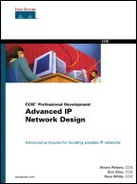Establishing Neighbor Relationships in an EIGRP Network
EIGRP conserves network bandwidth by using nonperiodic, incremental updates, which means changes to the network topology are transmitted between routers as needed. There are no full routing updates once a neighbor relationship has been established, and there are no periodic updates.
The basic problem with nonperiodic updates is knowing when a path through a neighboring router is no longer available. There are no periodic updates to age routes and time them out.
Instead, EIGRP relies on neighbor relationships; if the neighbor router has learned that a path through is reachable, the path is assumed to be valid. Because neighbor relationships are so important to the operation of the protocol, it is important to look at them closely. Refer back to Figure C-1 and examine the neighbor relationship between Routers A and B.
Assume Router B is powered up and running; when Router A is powered on, it will begin sending hello packets out to the multicast address 224.0.0.10 on each of its interfaces. When Router B receives Router A's first hello (only one simple situation will be examined here), it will send a hello packet with the initialization bit set. Router A will receive this hello packet with the initialization bit set and begin transmitting its full routing table to Router B.
Once Routers A and B have finished exchanging their routing tables, they will maintain this neighbor relationship with periodic hello packets. This raises the question of how often to transmit hello packets.
Determining how often to send hello packets is a matter of balancing between fast convergence and minimal network utilization. On higher speed and point-to-point links it's generally safe to transmit hello packets rather frequently, whereas on lower bandwidth, multipoint links conservation of bandwidth becomes more important.
Specifically, hellos are sent every 5 seconds on:
Broadcast media, such as Ethernet, Token Ring, and FDDI
Point-to-point serial links, such as PPP or HDLC leased circuits, Frame Relay point-to-point subinterfaces, and ATM point-to-point subinterfaces
High bandwidth, multipoint circuits, such as ISDN, PRI, and Frame Relay multipoint circuits greater than T1 (as configured using the interface bandwidth command)
Hellos are sent every 60 seconds on multipoint circuits of T1 bandwidth or slower, such as Frame Relay multipoint interfaces, ATM multipoint interfaces, ATM switched virtual circuits, and ISDN BRIs.
The rate at which hello packets are sent is called the hello interval and can be adjusted per interface using the ip eigrp hello-interval command. The amount of time that a router will consider a neighbor up without receiving a hello (or some other EIGRP packet) is called the hold time, and is typically three times the hello interval; so, the hold times are 15 seconds for a 5 second hello interval and 180 seconds for a 60 second hello interval by default. The hold time can be adjusted with the ip eigrp hold-time interface command.
Note
Note that if you change the hello interval, the hold time is not automatically adjusted to account for this change. You must manually adjust the hold time to reflect the configured hello interval.
It is possible for two routers to become EIGRP neighbors even though the hello and hold timers do not match because the hold time is included in hello packets. A router will keep a neighbor up as long as it receives hello packets from that neighbor within the hold time advertised in the neighbor's hello packet.
Although there is no direct way to determine the hello and hold intervals, executing show ip eigrp neighbor several times in a row can give you a good idea of what the hello interval and hold timers are for a neighboring router. (show ip eigrp neighbor cannot be used to determine the hello and hold timers on this router.) For example:
router#show ip eigrp neighbor
IP-EIGRP neighbors for process 1
H Address Interface Hold Uptime SRTT RTO Q Seq
(sec) (ms) Cnt Num
1 10.1.1.2 Et1 13 12:00:53 12 300 0 620
0 10.1.2.2 S0 174 12:00:56 17 200 0 645
router#show ip eigrp neighbor
IP-EIGRP neighbors for process 1
H Address Interface Hold Uptime SRTT RTO Q Seq
(sec) (ms) Cnt Num
1 10.1.1.2 Et1 12 12:00:55 12 300 0 620
0 10.1.2.2 S0 173 12:00:57 17 200 0 645
router#show ip eigrp neighbor
IP-EIGRP neighbors for process 1
H Address Interface Hold Uptime SRTT RTO Q Seq
(sec) (ms) Cnt Num
1 10.1.1.2 Et1 11 12:00:56 12 300 0 620
0 10.1.2.2 S0 172 12:00:58 17 200 0 645
The Hold column will never get above the hold time and should never get below the hold time minus the hello interval (unless, of course, you are losing hello packets). If the Hold column usually ranges between 10 and 15 seconds, the hello interval is 5 seconds and the hold time is 15 seconds. If the Hold column usually has a wider range—between 120 and 180 seconds—the hello interval is 60 seconds and the hold time is 180 seconds. If the numbers do not seem to fit one of the default timer settings, check the interfaces on this router and the neighbor because the timers have probably been configured manually.
It's possible for a link that can pass traffic in only one direction to result in a "half relationship" between two neighbors. Both routers will report retransmission limit exceeded errors at the console, and one router will have high Q Counts and an SRTT of zero in show ip eigrp neighbor.
